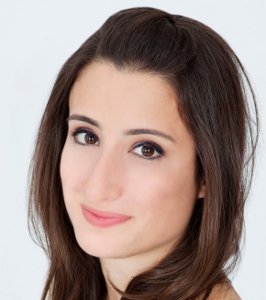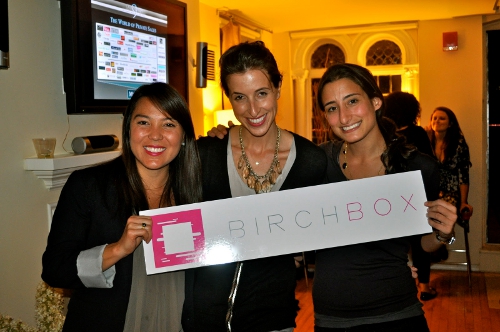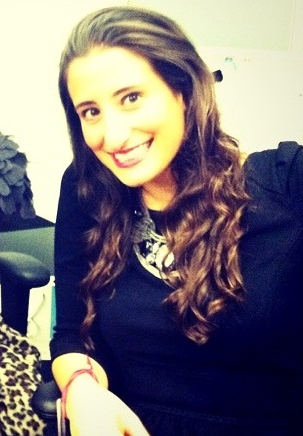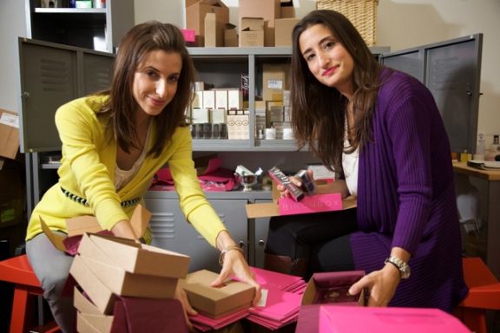- How Did Birchbox Prove Their Fashion Business Model Was Viable?
- What Percentage Of Hayley Barna’s Tech Company Is Women?
- How Do Beauty Samples Work And Do Big Brands Like Them?
Full Interview Audio

Personal Info
Favourite Books:
- Cloud Atlas by Doug Mitchell
- Judgment Under Uncertainty: Heuristics and Biases by Daniel Kahneman
Most Influenced By:Sheryl Sandberg, Meg Donahue
Twitter: http://twitter.com/hayleybay
Website: http://birchbox.com
Interview Highlights
This is a condensed, lightly edited transcript of an audio interview. The full audio is available and highly recommended. The interviewee may post clarifications in the comments.
Adrian Bye: Today I’m here with Hayley from Birchbox. Birchbox is one of the top fashion startups and I’m very glad to have you here. Hayley, thanks for joining us. 
Hayley Barna: Thanks for having me.
Adrian Bye: Hayley, tell us about who you are and where you come from. Birchbox sounds like a pretty amazing company.
Hayley Barna: I’m co-founder of Birchbox, a business that I started with a friend from corporate business club about three years ago. Before business school I was working in management consulting at Bain & Company in New York and got great exposure to a wide range of industries, everything from telecoms, to retailers, to financial services. I was lucky enough to work in consulting between 2005 and 2008 when the economy was growing, and so it was growth strategy type of stuff. I’m originally from the New York area.
Adrian Bye: I saw part of an interview that you did with Chris Dixon. You were talking about some of the processes that you used to start Birchbox. You were specifically talking about using Lean. I’d love to hear how you guys came up with the idea of Birchbox and then how you applied Lean. It sounds as if you really nailed it.
Hayley Barna: We came up with the idea for Birchbox influenced by a lot of different things. One was our own experience as consumers; seeing that a lot of categories were shifting online pretty effectively but realizing that the beauty category, one that you really have to touch, try and feel in order to make a new purchase decision, hadn’t shifted online; also seeing the the group buying, the flash sales, a lot of the innovations in online retail were discount driven; and thinking there was a better way to do that, specifically for beauty. So our vision was to create a discovery commerce platform, a way for brands to get their products in the hands of customers that would value it, and to help customers discover new products and new brands that they would love.
Adrian Bye: So you were actually taking the Groupon model and applying it to beauty and the fashion?
Hayley Barna: Not exactly. The Groupon model is quite different. We’re focused on new customer acquisitions. At the beginning of a product life cycle the beauty industry is really driven by product launches, by changing trends. And there was this built-in industry behavior of sampling. But that was traditionally done as a loyalty program for existing customers. We saw an opportunity to create an online platform that could sample to new customers in a targeted and ROI-efficient manner. Getting customers to opt in to this experience, to pay $10 and say: ‘Birchbox, please send me a selection of high-end products tailored to me and my needs and preferences’; and through that help them discover new things that they wouldn’t have considered otherwise and for the brand help them find new customers and get a great return on investment for their sampling dollars. 
Adrian Bye: So how did you come up with the idea?
Hayley Barna: The kernel of idea was sending a personalized assortment of products to a customer’s home every month. Definitely influenced by the idea of a magazine, being able to get a physical product into customers’ homes that would really get their attention. Then we realized that, just like a magazine, being able to put those products in contact to tell customers why they’re great, how to get most out of them would be important. We do that through writing editorial articles, having how-to videos on our site. And then lastly, the third piece of the try-learn-buy model is the fact that we sell full-size versions of the products that we sample. That’s important for the customer experience to have that happen seamlessly, but also really essential for a brand partner. And we needed that to track the conversion rate of our sampling effort.
Adrian Bye: The initial coming up with the idea, is this something that you did analytically figure out through looking at lots of different business ideas? Or was this something that you wanted to do yourself?
Hayley Barna: The idea really found us. Katie and I were in business school. We weren’t one of the students who were dead set on finding an idea before we graduated. We just started playing around with this idea of product discovery through targeted trial, and we couldn’t stop thinking about it. And then we had a decision point: we can write a business plan, like a word document about this, or we can get out there in the world and see if it would actually work. The latter just sounded way more fun. So we quickly went from brainstorming to actually contacting beauty brands and asking them to purchase a place in a beta test.
Adrian Bye: How many brands did you start with?
Hayley Barna: Our beta test was pretty limited in scope. We wanted to send out two months of Birchboxes to 200 customers. Birchboxes have four to six products in them. So we needed eight brands to give us 200 samples each in order to get the beta test started.
Adrian Bye: So you had the idea, you guys couldn’t stop thinking about it, and then you said okay, we’re going to do a test of eight products to 200 people to see if it works. Then you went and found eight brands that were willing to give you enough products and that was the start of your test. Is that how it came together?
Hayley Barna: Exactly. We are a platform so we could have started on the customer side or on the brand side. But it was really obvious to us, and still is, that the success of our products depends on having great brands and great samples. So we started there, getting the commitments from these eight beauty brands. Then we built the site and then we went out and got customers. 
Adrian Bye: Had that failed and you hadn’t been able to get those companies on board you would have said, okay, maybe this idea is not the right one?
Hayley Barna: Yes. That was the point of the beta, a sort of a proof of contest. We needed to prove three things essentially. The first was: will brands want to work with us? Do they think that being able to shift beauty product sales online is a pain point? Our first meetings confirmed that. We were in the right place at the right time. They were seeing the shift and wanted to have a better way, a better partner to be doing it with and we were like answers for them. The second thing we were testing was: Will consumers pay for samples? As I said before, sampling was traditionally done as a royalty program, as a free gift with purchase. Our idea that customers would be willing to pay for a surprise set of targeted samples was a big behavioral change and something that we needed to prove. And lastly, in terms of making the economics in the business model work was testing whether if we send these samples to the customers, would they turn around and buy four, five versions of the products that they sampled? Those were the three things we tested in the beta test.
Adrian Bye: Why did you build the site? You start with the brands, why not just pass around flyers at the university to get 200 signups and test it that way?
Hayley Barna: I think a few reasons. The first was that we were committed to having an unbiased panel of customers for a test. So we made sure that we addressed people that didn’t know us, that weren’t in the bubble of being on campus. That was just in terms of the customer side. We had a big vision from the beginning that what we were building was the best place to buy beauty products online. And that would be made possible through personalization based on profile and behavioral data. That we would get both explicitly by our customers telling us what they wanted but also implicitly through their browsing behavior and their purchase behavior. And a website was necessary for that, even in the beginning.
Adrian Bye: So you built the site and drove a bunch of signups through Google and Facebook?
Hayley Barna: We used some sort of friends-of-friends method. My co-founder and myself each made a list of twenty people we knew in different stages of their lives and different cities around the country. We sent those friends an email saying, ‘We’re testing something and we don’t want you to sign up, but we would really love if you’d forward it to any distribution list that you’re on or to your friends that you think might be interested.’ We used MailChimp and were able to see that those forty emails turned into thousands of opens and we were able to get that 200 customers pretty quickly.
Adrian Bye: Wow, that’s very smart. I’ve never heard of anyone doing it that way before.
Hayley Barna: Yes, it worked well for us. I think part of it was that we were really open, like this is a test, this is something new, and by signing up to this you are helping us figure out if this new idea will work. 
Adrian Bye: So you had 200 signups, you shipped 2 months’ worth of Birchbox to people. And then what happened?
Hayley Barna: We looked to see how customers would react. We were checking conversion rates. Were people logging back into the site, read the content we had written about the products and pressing those buy-buttons to get full-size versions? We were really happy with the conversion rate that we saw, We were able to package up that 2 months’ worth of data in those learnings and go back to our brand partners and show them that the pilot test that we had run worked well and that we were planning on graduating from Harvard Business School without jobs in order to launch Birchbox on full scale. And that’s what we did.
Adrian Bye: Did you pay the partners for the samples?
Hayley Barna: No, we did not, and that’s still how it works. Sampling is an important part of how the beauty industry does spend their marketing expense. Basically we were telling them to take that existing marketing expense and shift it to Birchbox and we’ll get you a higher return. We’ll be able to get more impressions for you, we’ll be able to generate more sales, both through our shop on Birchbox, but also through other channels.
Adrian Bye: So there were actually three key components to your model that you had to validate, right? Would the companies give samples? Would consumers be interested? And then, would there be a good enough conversion rate on the samples to make it worthwhile?
Hayley Barna: Exactly. If we’re doing the right things, the brands and the customers will be happy. The customers will buy more products, the brands will see a better ROI, they’ll give us more samples. That also helps us scale, and as we scale, we are better able to target those samples based on customers’ profiles and their past behavior. And it just started to snowball from there.
Adrian Bye: Are you able to talk about conversion rates that you see?
Hayley Barna: Not in detail, but we have been able to scale significantly and I think our last published figure was that we were well over 300,000 subscribers. That’s a lot of samples. So the brands are very happy with the return that we are able to get them.
Adrian Bye: That means every month there are at least 300,000 subscribers that are paying you $10 a month to be part of this program, which I guess effectively covers the shipping and handling on your side. Maybe you get a little bit of money out of that. Do you make commissions then from the brands when people come and buy stuff?
Hayley Barna: Our two main revenue chains are the subscription site and then we are retailers for the full-size products. So when we sample something we take inventory of that product and we work hard for the brands, but also work hard for ourselves to make that conversion happen. So it’s not commission, it’s retailer.
Adrian Bye: I guess you can very easily do some sort of a test to see if something is going to work and then you have your conversion rate and then you can go and do it?
Hayley Barna: Exactly, we do that pretty frequently. We sample a smaller amount of a product and then we see which demographic converted higher. Then next time we sample a lot more and will target it appropriately so that we are sending it to the people most likely to love it and to buy it.
Adrian Bye: Do brands really like what you’re doing?
Hayley Barna: Yes. We have over 400 brand partners and we create very deep relationships with our brand partners. Some of them have grown from being relatively small to being much, much larger through Birchbox. It’s almost like a consultative relationship where they really go to us to ask questions about trends, about packaging, about what we’re seeing out there in our increasingly large customer base.
Adrian Bye: I’m curious how you’re finding the tech space. I mean, there are a lot of dorky guys around and you have to deal with dorky guys and manage them, especially in a fast growing company. That might be quite challenging sometimes.
Hayley Barna: Not an issue for us. I have a long history of really enjoying working with dorky guys. I went to Harvard College Undergraduate and I was probably one in ten women who took the intro to computer science class. I’ve never shied away from that sort of environment. But in the US office we have about 120 full-time employees and we’re close to 80% female. Not on purpose, but our tech team is more female than an average tech team. Our CTO is female, she has a PhD from Carnegie Mellon. And we have a lot of really, really smart female engineers and product managers working at Birchbox as well.
Adrian Bye: That’s got to be an unusual internet company environment. I’m surprised I haven’t really seen that discussed around on the net.
Hayley Barna: We’re really proud of it. You might think they may work here because they like makeup, but they are just excited to be working on really interesting technical challenges and problems. And they created a really great culture on the tech team specifically where they can really have ownership over the features and the projects that they are working on.
Adrian Bye: Ok. Hayley, thanks for doing the interview.
Hayley Barna: Thank you, that was fun.









